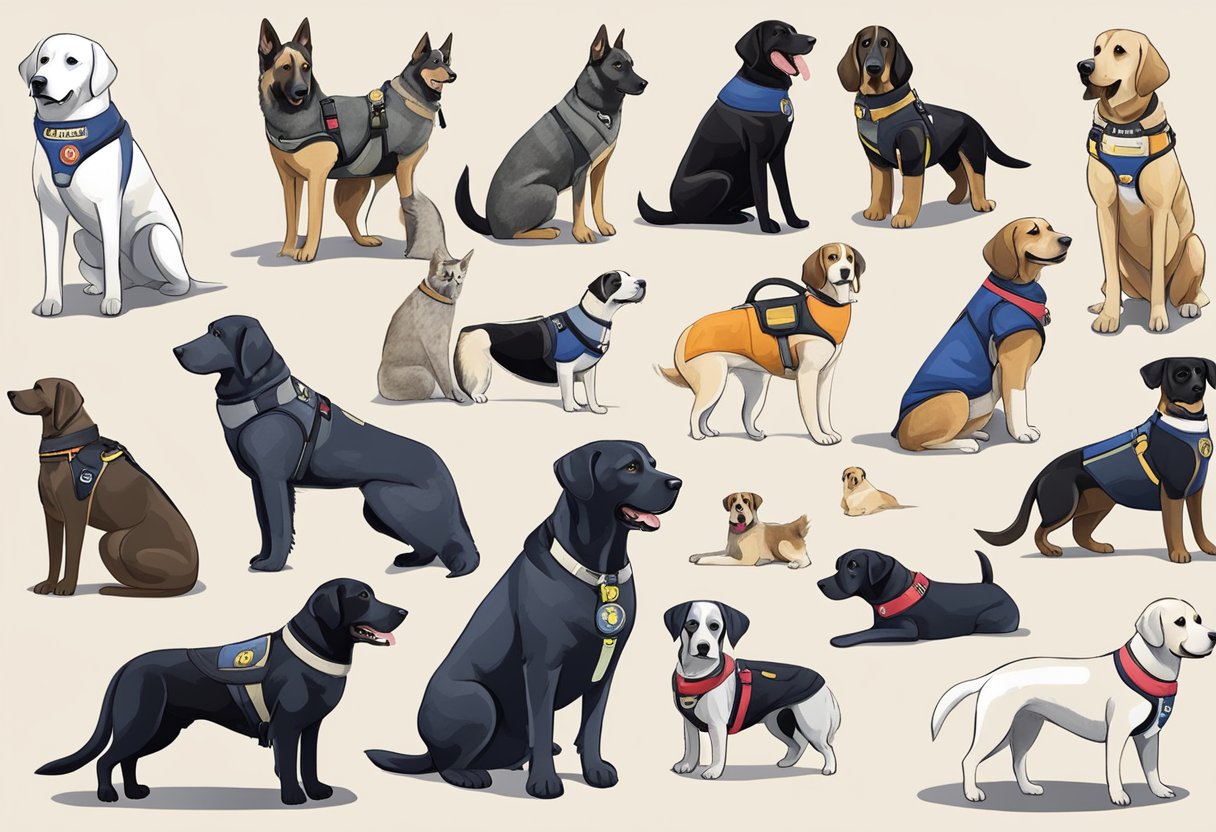Types Of Service Dogs
Service dogs are specially trained dogs that help people with disabilities in their daily lives. They are trained to perform specific tasks to assist their owners, such as guiding the blind, alerting the deaf, detecting seizures, and providing emotional support. Service dogs are an important part of many people’s lives, and they can make a significant difference in the quality of life for those who rely on them.
There are many different types of service dogs, each trained to perform specific tasks for people with different disabilities. Some of the most common types of service dogs include guide dogs, hearing dogs, mobility assistance dogs, psychiatric service dogs, and autism assistance dogs. Each type of service dog is trained to perform specific tasks that are tailored to the needs of the person they are assisting.
It is important to note that service dogs are not pets, but rather working animals that provide an essential service to their owners. They are highly trained and certified to perform their duties, and they are protected by law. In the United States, the Americans with Disabilities Act (ADA) provides legal protections for service dogs and their owners, ensuring that they have equal access to public places and accommodations.
Types of Service Dogs

Service dogs are specially trained animals that assist people with disabilities in performing everyday tasks. There are various types of service dogs, each trained to perform specific tasks. Here are some of the most common types of service dogs:
Guide Dogs for the Visually Impaired
Guide dogs, also known as seeing-eye dogs, are trained to assist people who are visually impaired or blind. These dogs help their owners navigate obstacles and avoid hazards while walking. They are trained to stop at curbs, steps, and other obstacles, and to indicate when it is safe to cross the street.
Hearing Dogs for the Deaf
Hearing dogs, also known as signal dogs, are trained to assist people who are deaf or hard of hearing. They are trained to alert their owners to important sounds such as doorbells, smoke alarms, and telephone rings. They can also alert their owners to the presence of people or animals.
Mobility Assistance Dogs
Mobility assistance dogs are trained to assist people with mobility impairments. They can help their owners with tasks such as opening doors, retrieving objects, and pulling wheelchairs. They can also provide stability and balance support to their owners.
Diabetic Alert Dogs
Diabetic alert dogs are trained to alert their owners to changes in blood sugar levels. They can detect changes in blood sugar levels through scent and can alert their owners before a dangerous situation occurs.
Seizure Alert and Response Dogs
Seizure alert and response dogs are trained to assist people with epilepsy or other seizure disorders. They can alert their owners to an oncoming seizure and provide assistance during and after the seizure.
Autism Support Dogs
Autism support dogs are trained to assist people with autism spectrum disorder. They can provide comfort and companionship to their owners and can help them navigate social situations.
Psychiatric Service Dogs
Psychiatric service dogs are trained to assist people with mental health conditions such as anxiety, depression, and post-traumatic stress disorder. They can provide emotional support, help their owners manage symptoms, and assist with daily tasks.
Each type of service dog is trained to perform specific tasks to assist their owners with disabilities. These dogs are not pets but are highly trained animals with important jobs to do.
Service Dog Training and Certification
Service dogs are highly trained animals that perform specific tasks to assist individuals with disabilities. Training a service dog is a rigorous process that requires time, patience, and expertise. Certification is also an important step that ensures that the dog is well-trained and can perform its tasks safely and effectively.
Training Requirements
Service dog training involves teaching the dog specific tasks that are tailored to the individual’s needs. The training process can take up to two years, and it typically involves several stages. The first stage is basic obedience training, which includes commands such as sit, stay, and come. After the dog has mastered these commands, it moves on to more advanced training, such as task-specific training.
The training should be conducted by a professional dog trainer who has experience working with service dogs. The trainer should use positive reinforcement techniques to motivate the dog and build its confidence. It is important to note that service dogs are not pets, and they need to be treated as working animals.
Certification Process
Certification is an important step that ensures that the service dog is well-trained and can perform its tasks safely and effectively. However, there is no national certification or registration requirement for service dogs in the United States.
The Americans with Disabilities Act (ADA) does not require service dogs to be certified or registered. However, some organizations offer voluntary certification programs for service dogs. These programs provide a way for service dog handlers to demonstrate that their dogs have been trained to a certain standard.
Public Access Rights
Under the ADA, service dogs are allowed to accompany their handlers in public spaces, such as restaurants, stores, and hotels. The dog must be under control at all times and should not pose a threat to others.
It is important to note that emotional support animals and therapy dogs are not considered service dogs under the ADA. These animals do not perform specific tasks to assist individuals with disabilities, and they do not have the same public access rights as service dogs.
In conclusion, service dog training and certification are important steps that ensure that the dog is well-trained and can perform its tasks safely and effectively. The ADA provides public access rights for service dogs, but there is no national certification or registration requirement for service dogs in the United States.
Legal Rights and Protections
Service dogs play an important role in the lives of individuals with disabilities. These specially trained animals are not just companions but also provide essential assistance to their owners. As such, there are laws in place to protect the rights of service dog handlers and ensure that they have equal access to public spaces and housing.
Americans with Disabilities Act (ADA)
The Americans with Disabilities Act (ADA) is a federal law that prohibits discrimination against individuals with disabilities. Under the ADA, service dogs are considered a reasonable accommodation for individuals with disabilities. This means that service dogs are allowed to accompany their owners in all public spaces, including restaurants, schools, and other places of business.
The ADA also protects the rights of service dog handlers in the workplace. Employers are required to make reasonable accommodations for individuals with disabilities, including allowing service dogs in the workplace.
Fair Housing Act
The Fair Housing Act is a federal law that prohibits discrimination in housing based on race, color, religion, national origin, , familial status, and disability. Under the Fair Housing Act, landlords and property managers are required to make reasonable accommodations for individuals with disabilities, including allowing service dogs in housing units that have a “no pets” policy.
Access to Public Spaces
Service dogs are allowed access to all public spaces under the ADA. This includes restaurants, schools, and other places of business. However, service dogs must be well-behaved and under control at all times. If a service dog becomes disruptive or aggressive, the owner may be asked to remove the dog from the premises.
In conclusion, service dogs provide essential assistance to individuals with disabilities. The ADA and the Fair Housing Act provide legal protections for service dog handlers and ensure that they have equal access to public spaces and housing. It is important for individuals with disabilities to understand their legal rights and for businesses and landlords to make reasonable accommodations for service dogs.
Choosing the Right Service Dog
When it comes to choosing the right service dog, there are several factors that must be taken into consideration. Here are some important things to keep in mind:
Breed Considerations
Different breeds of dogs have different temperaments and characteristics that make them better suited for certain types of work. For example, German Shepherds are known for their loyalty, intelligence, and protective instincts, which make them great for tasks such as guiding the visually impaired or providing assistance to those with mobility issues. Poodles, on the other hand, are highly trainable and hypoallergenic, making them a popular choice for those with allergies or asthma.
Size and Temperament
The size and temperament of a service dog are also important considerations. For example, a larger dog may be better suited for tasks such as pulling a wheelchair or providing stability to someone with balance issues. However, a smaller dog may be more appropriate for tasks such as retrieving items or providing emotional support. It is also important to consider the temperament of the dog, as a service dog should be calm, well-behaved, and able to focus on its tasks.
Matching Dog to Disability
When choosing a service dog, it is important to match the dog to the specific disability of the handler. For example, a dog trained to assist someone with hearing loss may need to be able to alert its handler to sounds such as a doorbell or fire alarm. A dog trained to assist someone with PTSD may need to be able to provide comfort and support during times of distress. It is important to work with a reputable service dog organization to ensure that the dog is trained to meet the specific needs of the handler.
In conclusion, choosing the right service dog requires careful consideration of factors such as breed, size, temperament, and matching the dog to the handler’s disability. By taking the time to carefully evaluate these factors, handlers can ensure that they are matched with a service dog that is best suited to meet their needs.
Living with a Service Dog
Living with a service dog can greatly improve the quality of life for people with disabilities. Service dogs are trained to perform specific tasks that their handlers cannot do on their own. They provide emotional support, comfort, and love to their handlers, and help them live more independently.
Daily Care and Responsibilities
Owning a service dog comes with daily care and responsibilities. Service dogs require regular exercise, grooming, and veterinary care to stay healthy. Handlers must also provide proper nutrition and hydration to their service dogs. It is important for handlers to keep their service dogs clean and well-groomed to maintain their health and hygiene.
Handlers must also be responsible for their service dog’s behavior in public. They must ensure that their service dog is well-behaved and follows all commands. Handlers must also respect the rights of others and not bring their service dog into areas where they are not allowed.
Emotional and Social Benefits
Service dogs provide emotional and social benefits to their handlers. They offer unconditional love and support, which can help reduce stress and anxiety. Service dogs also help their handlers feel more confident and independent, which can improve their overall quality of life.
Service dogs wear vests that identify them as working dogs and signal that they are providing a service to their handler. This helps the public understand that the dog is not a pet, but rather a trained service animal. Handlers may also use the vest to communicate with the public and indicate whether their service dog is approachable or not.
Overall, living with a service dog requires responsibility and commitment, but the benefits are significant. Service dogs provide their handlers with the assistance they need to live more independently and with greater quality of life.






